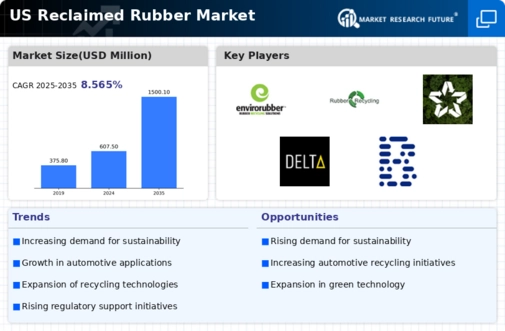The reclaimed rubber market is currently characterized by a dynamic competitive landscape, driven by increasing environmental awareness and the demand for sustainable materials. Key players are actively engaging in innovative practices and strategic partnerships to enhance their market positioning. Liberty Tire Recycling (US) has focused on expanding its recycling capabilities, emphasizing the importance of sustainability in its operations. Meanwhile, Goodyear Tire & Rubber Company (US) has been investing in advanced technologies to improve the quality of reclaimed rubber, thereby enhancing its product offerings. These strategies collectively contribute to a competitive environment that prioritizes sustainability and innovation.
In terms of business tactics, companies are increasingly localizing manufacturing and optimizing supply chains to reduce costs and improve efficiency. The market appears moderately fragmented, with several key players exerting influence over their respective segments. This fragmentation allows for a variety of approaches to market entry and expansion, as companies seek to differentiate themselves through unique value propositions.
In November 2025, Bolder Industries (US) announced a partnership with a leading automotive manufacturer to supply reclaimed rubber for tire production. This collaboration is significant as it not only enhances Bolder's market reach but also underscores the growing acceptance of reclaimed materials in mainstream manufacturing. Such partnerships are likely to pave the way for broader adoption of sustainable practices within the industry.
In October 2025, Lehigh Technologies (US) launched a new line of high-performance reclaimed rubber products aimed at the automotive sector. This strategic move is indicative of Lehigh's commitment to innovation and its ability to meet the evolving needs of its customers. By focusing on high-performance applications, Lehigh positions itself as a leader in quality, which could potentially attract new clients seeking reliable materials.
In September 2025, Continental Tire (US) expanded its recycling operations by acquiring a state-of-the-art facility dedicated to processing end-of-life tires. This acquisition is crucial as it not only increases Continental's production capacity but also enhances its sustainability profile. The integration of advanced recycling technologies is expected to improve the efficiency of reclaimed rubber production, thereby reinforcing Continental's competitive edge.
As of December 2025, the most pressing trends shaping competition in the reclaimed rubber market include digitalization, sustainability, and the integration of AI technologies. Strategic alliances are becoming increasingly vital, as companies recognize the need to collaborate in order to innovate and meet consumer demands. Looking ahead, competitive differentiation is likely to evolve from traditional price-based strategies to a focus on innovation, technological advancements, and supply chain reliability. This shift suggests that companies that prioritize these elements will be better positioned to thrive in an increasingly competitive landscape.
















Leave a Comment